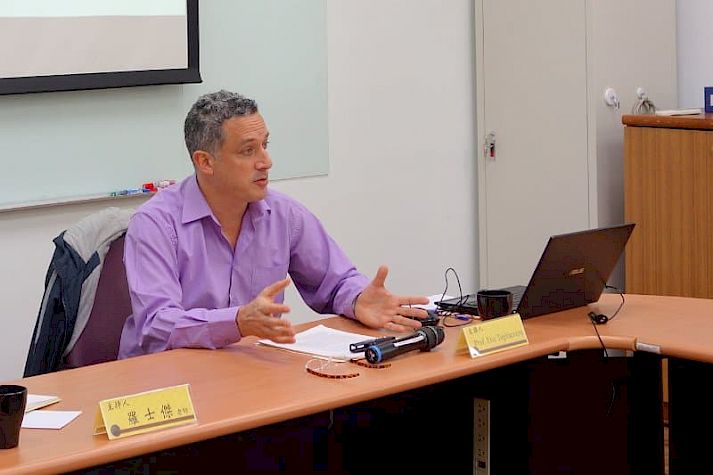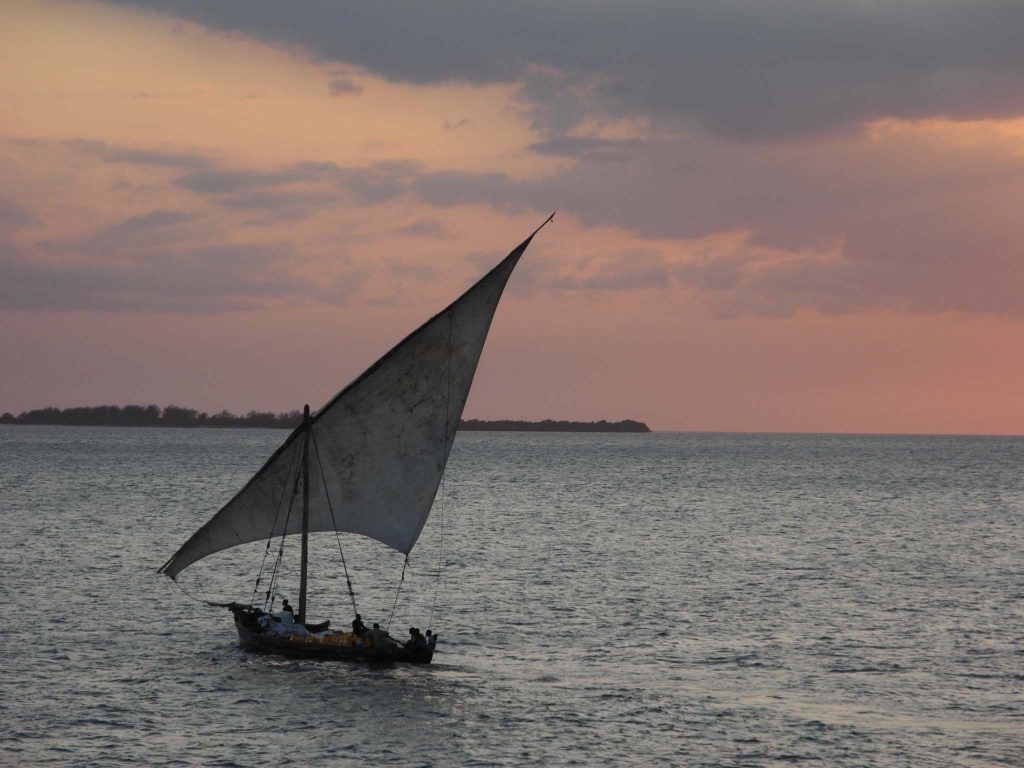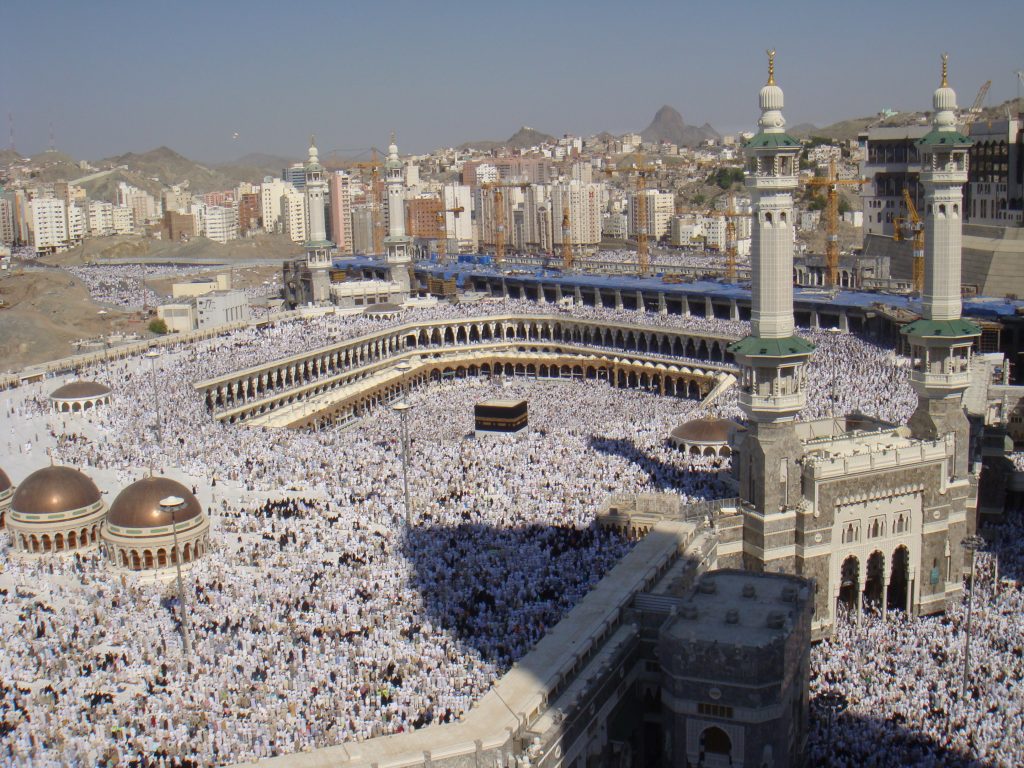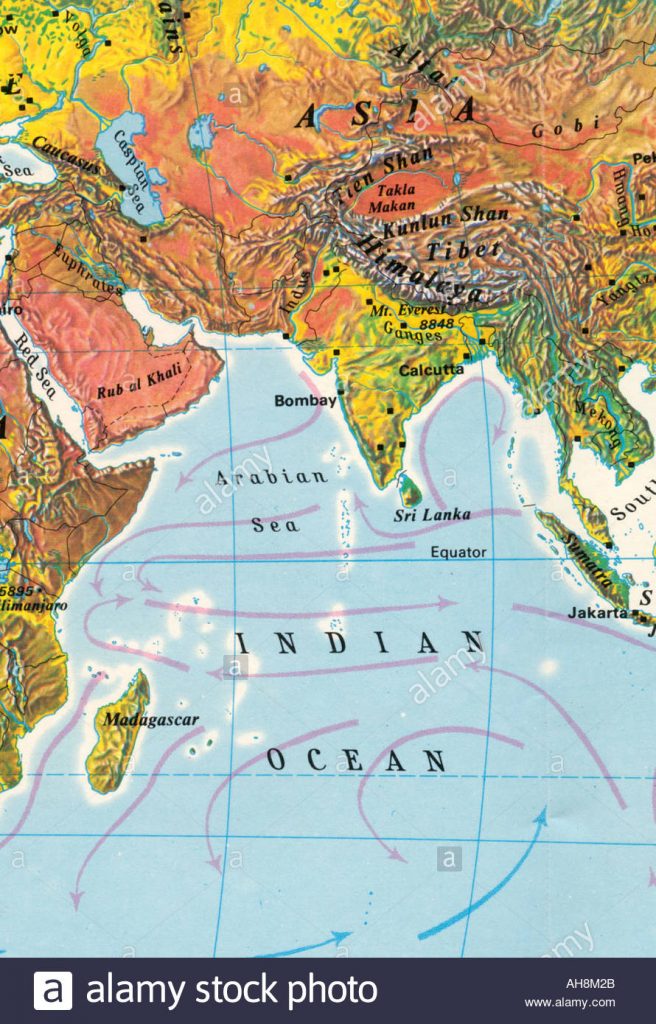From Istanbul to Tokyo: An Interview with Eric Tagliacozzo

In 2018, over 2.3 million people went on hajj, the annual pilgrimage to Mecca that takes place during the final month of the Islamic lunar calendar, Dhu al-Hijjah. The pilgrimage is one of the Five Pillars of Islam (alongside Shahadah, Salat, Zakat and Sawm) and is mandatory for all able-bodied Muslims financially capable of making the journey. Although Muslims make the journey every year from all around the world, the country with the highest percentage of hajjis per capita is not in northern Africa or the Middle East, considered by most to be the center of dar al-Islam (the Abode of Islam), but rather in Southeast Asia: Indonesia.
So observes Eric Tagliacozzo, Professor of Modern Southeast Asia at Cornell University, in his most recent monograph, The Longest Journey: Southeast Asians and the Pilgrimage to Mecca (Oxford University Press, 2013). In examining the annual movement of pilgrims from the opposite ends of the Indian Ocean, Tagliacozzo taps in to a process that has been taking place for more than five hundred years: first by sail, then by steam, then by air. Connections between Southeast Asia and the Middle East do not center solely on Islam. They are part of a far more complex network of trade, movement, and cross-cultural exchange. These connections between Southeast Asia and the Middle East are part of a far wider set of connections between peoples along the entire Indian Ocean littoral from eastern Africa to the South China Sea.
As historians have turned to more transnational and global histories in the late 20th and early 21st centuries, the field known as the "Indian Ocean world" has blossomed. Studies of the Indian Ocean world focus on the movement and settling of people from all around the Indian Ocean littoral and hinterland regions, which form a single interconnected arena. They examine how connections between peoples in the Indian Ocean world long pre-dated European colonialism. They explore how those connections persisted through the colonial period, both by using and subverting colonial networks. Together, they trace these movements from the pre-colonial to the post-colonial, demonstrating continuities over time that do not exist solely in reference to Europe.
Tagliacozzo himself has significantly contributed to this literature. His work has added enormously to historians' knowledge of not just Indonesia, Malaysia, Burma, and other parts of Southeast Asia–which was his original region of focus–but also the South China Sea, the Arabian Peninsula, and Southwest Asia (the Middle East) all the way to Istanbul. He has demonstrated the deep-seated connections between these regions and the peoples that inhabit them, thereby adding color, breadth, and depth to previously separated national and regional histories. Since the start of his career, Tagliacozzo has worked on these networks in monographs including Secret Trades, Porous Borders: Smuggling and States Along a Southeast Asian Frontier, 1865-1915 (New Haven: Yale University Press, 2009) and The Longest Journey (New York: Oxford University Press, 2013).
In this interview, we talked with Tagliacozzo about his previous works and his contributions to scholarship on the Indian Ocean world as well as transnational and global history. We spoke about his days as a 22-year old college student interviewing spice traders from Japan to East Africa. Our discussion ranged from illicit trade in rhinoceros horns to itinerant peoples' methods of resistance to colonial rule. And we discussed how, often, those two things were one-and-the-same.
– Matthew Bowser
MATTHEW BOWSER: You are primarily an historian of Southeast Asia. What first got you interested in the region? Did you decide to focus on Southeast Asia in graduate school or did the decision come earlier?
ERIC TAGLIACOZZO: I had a bit of an unusual introduction, actually. I went to a small liberal arts college, Haverford College outside Philadelphia, a good Quaker school. I was extremely lucky at the end of my college experience, and I got something called a Thomas Watson Fellowship. The Watson Foundation was started by Thomas Watson, who was the founder of IBM, and he endowed a scholarship for something like fifty or sixty, or maybe even seventy, graduating college seniors from small liberal arts colleges all over the United States and Canada to go off into the world and do a project that they had always been interested in. Of course, you had to be able to show that you had the preparation to do this kind of project, so they did a competitive search across North America for this every year.
I was extremely lucky and got one of these Thomas Watson Fellowships. So, as a 22-year old, I left the U.S., and I ended up spending a year talking to and doing interviews with spice traders all over the Indian Ocean and the South China Sea. I spent time from Japan all the way to East Africa, a lot of that time on ships speaking to these spice traders in various ports, trying to figure out the history of the global spice trade. And the place that interested me most on those travels was Southeast Asia. Southeast Asia seemed almost like the center of the sea routes going from the Middle East all the way to Japan and back. It acted as a hinge of sorts in the middle of those sea routes, so it interested me the most of all the places that I was traveling to and doing these interviews.
MATTHEW BOWSER: You focus on smuggling in your first articles and in your first book, Secret Trades, Porous Borders: Smuggling and States Along a Southeast Asian Frontier, 1865-1915. What drew you to smuggling as a topic? What opportunities did smuggling offer for breaking new historiographical ground?
ERIC TAGLIACOZZO: So when I was away on that Watson Fellowship, one of the things that I noticed was there was a lot of trade going on underneath the more commonly traded goods that we all read about in the news, and I slowly started to understand that there was this entire world that existed outside of common trade items. I actually made up a word for this, "undertrading," to look at the passage of these different kinds of goods that were traveling underneath the much larger current of what we think of as "world trade."
When I was doing these interviews, I would go into these spice shops and occasionally I would see things. For example, in Chinese pharmacies, they would have a little metal rhinoceros, and I wanted to know what that was. I would ask people but I would only get these vague answers at first. I did many of these interviews in Chinese with Chinese traders, but I also talked with Indian traders, mostly in English, and I was slowly picking up Indonesian. So, eventually, I found out that those little metal rhinoceroses were an understood symbol that you could buy powdered rhinoceros horn, which is an aphrodisiac in the Chinese pharmacopeia, but it's illegal to sell it.
It was moments like that helped me begin to realize that there were, in fact, these larger trades circulating underneath these more visible trades spanning the world that we see every day, every month, and every year. So whatever the reams of statistics tell us about GDP and international trade, there is a consistent current of commerce that goes on underneath and at the interstices of these larger, more common trades. That was what interested me during my Watson Fellowship and that ultimately became my topic for my dissertation at Yale.

A dhow off the coast of Zanzibar. Courtesy of Eric Tagliacozzo.
MATTHEW BOWSER: As a student of Islam in Southeast Asia, I first came upon your work on the connections between Southeast Asia and the Middle East. Like many historiographical developments, the connection seems intuitive in retrospect, but you were one of the first to write about it. How did you first become interested in studying this connection?
ERIC TAGLIACOZZO: Well, there were certainly others before me. I rode an earlier wave of people that were interested in these connections between Southeast Asia and the Middle East and were starting to publish on this. So I certainly don't get pride of place in this. But it was unusual to write about it, because most of the work about Islam and the history of Islam was patterned on the Middle East. Southeast Asia was about as far from the "Muslim center," or what we think of as the center of Islam in the Arabian peninsula, that to focus on that region was not as common.
For me, it really came about because in my research for Secret Trades, which was focused on mainly smuggling, I came across evidence of the smuggling of pan-Islamic newspapers from the Middle East to Southeast Asia. The colonial authorities were nervous about this and kept files on it, because these were newspapers that advocated these global Islamic connections, and the throwing off of the rule and the yoke of Christian powers. This was a deeply interesting connection, but because I was focused on writing a book about the history of smuggling, this topic only got three or four pages in the middle of a four-hundred-something page book.
But I started to keep a file on it. A manila folder started to fill with more and more archival citations and things I had read in different places about Middle Eastern ideas, about Islam moving to Southeast Asia and Southeast Asian ideas of Islam moving back to the Middle East. Eventually that research started to germinate into the seeds of my new book about the history of the hajj from Southeast Asia.
MATTHEW BOWSER: That leads me directly into my next question, which is on your work on the hajj. Studying Southeast Asians who made this journey is a natural progression from your earlier work on connections between Southeast Asia and the Middle East. How did this project change your understanding of these connections?
ERIC TAGLIACOZZO: Yeah, it turned out that the hajj really was very important to understanding these connections. In some years, around the fin de siècle period (the late 19th and early 20th century), something like 50% of all global pilgrims going to Mecca from the entire Muslim world could be coming from Southeast Asia at any given time. That's not every year in that period, but the numbers were always significant. So, it's kind of ironic right? You go as far away as you can in the dar al-Islam, the "Abode of Islam," which stretches from Morocco to Indonesia, and yet the further away you go, the more people you have going on hajj. That really interested me, and I started to feel that this topic was really worth a book.
Ever since I worked on that Southeast Asia and the Middle East volume (Stanford University Press, 2009), I had been interested in what kinds of connections we were examining. I looked at what other people in the volume had focused on (education, trade, missionization), and I started to realize that the hajj was extremely important to all of them, like a huge conveyer belt connecting the two regions. And it's still vital today. Indonesia is the world's largest Muslim country by population, which means that every year there are more Indonesians going on hajj than there are Muslims coming from any other nation-state in the world. The fact that it is still so important in today's world, and not just in a certain historical period, was one of the things that interested me most as an historian.

MATTHEW BOWSER: The colonial powers feared that the hajj was a vehicle of Islamic radicalism and sedition, a perception that has seen a resurgence in our current historical moment. How does your work address how colonial states dealt with the hajj in the nineteenth and twentieth centuries and how states deal with it today?
ERIC TAGLIACOZZO: Well, one of the things it does is show the longevity of these connections. Muslims were going from Southeast Asia to the Middle East by sail for hundreds of years in small numbers. By the middle decades of the nineteenth century, the journey starts to be by steam in larger numbers. And now it's a connection that moves almost entirely by air in even larger numbers. You really see that connection over time and how it's grown over the centuries, from something that began around the fourteenth century or so – when we have the first records of Southeast Asians appearing in the Hijaz – to now; it starts with a trickle and ends with a flood. And you're right: the colonial state was very fearful of what all these local indigenous Muslims from Southeast Asia were doing in the Middle East and what kind of activities they were up to when they came back. And of course, the modern, post-independence nation-state is often worried about these things too.
The big difference is that travel really started outside of government control but eventually became routinized as part of government-regulated processes. This started first through colonial control – and we have all kinds of records about this – such as the colonial pass system, which allowed Muslims to go from all these various colonies to the Middle East, but crucially all under the rubric of the colonial European powers. And that evolved to now, to where it's all organized through nation-states, and the Saudi authorities regulate by organizing with hajj bureaus in the various different countries. So following that thread from pre-colonial through colonial and into post-colonial realities has been really fascinating.
MATTHEW BOWSER: Your work focuses on the period of colonial rule in the Indian Ocean rim, but it mostly avoids direct confrontation with the colonial state. You generally focus rather on connections between people that move around and through imperial boundaries. Why? How does this emphasis alter historians' view of imperialism and colonialism in Asia?
ERIC TAGLIACOZZO: I actually am interested in the confrontation between states and indigenous subjects, but a different kind of confrontation than overt revolt. One of my teachers in graduate school was James Scott, and he very much helped to define that line of inquiry through studying how states and peasants got along with each other. His life-long career arc has been about how peasants try to resist the overreach of the state.
One of the things I realized as a graduate student working with Jim and with others at Yale was that if peasants could do this, how much more so could merchants, traders, smugglers, and other people who are itinerant – people who were not tied to the land, but in fact had capital by virtue of their professions, and also often had kin relations in far-flung geographies – how much more so could they resist against the strictures of the state? So it's a different kind of resistance than the kind of resistance that Jim made so popular, but it's related.
MATTHEW BOWSER: Institutions such as the Toynbee Prize Foundation encourage the recent trend toward global or world history; your work certainly fits within this mold. How does studying transnational connections such as those between Southeast Asia and the Middle East improve our knowledge of history?
ERIC TAGLIACOZZO: I think global connections are larger, wider, and more important than previously acknowledged. Whereas before we tended to have a normative narrative that the West was the one who opened up the world starting after the so-called "contact age," what I think more historians would be much more comfortable saying now is that much of the world was in conversation with other parts of the world for a very long time.
This wouldn't have been necessarily people moving trans-continental distances all by themselves, but rather moving in segmented realities. Occasionally, people like Ibn Battuta, Marco Polo, or Zheng He would make these much longer journeys, but we have fewer records of that. Instead, the reality of it is that we see the filigree – these patterns of connection, these webs of influence – by looking across the wider geographies. At least for me, as I've gotten older and have been a historian for a longer time, I've gotten more and more interested in these "big picture" histories.

MATTHEW BOWSER: You cite Braudel as early as your first book; his work is generally cited as being the inspiration for the present-day field of the "Indian Ocean world," based on earlier models such as the "Atlantic world." Do you consider yourself an Indian Ocean historian? Do you see value in such a label?
ERIC TAGLIACOZZO: Sure, yeah, I'd say I'm part of that collectivity; I'm an Indian Ocean historian like many other people. But I'm also very interested in the South China Sea and the history of that oceanic basin as well.
But you're right, Braudel was certainly there at the start, and there was also K.N. Chaudhuri as one of the founding figures in this collectivity with his Trade and Civilisation in the Indian Ocean (1983). As you move forward in time, there are others who joined as seminal figures: Sugata Bose, Sanjay Subrahmanyam, and more recently, Sunil Amrith, Kerry Ward, and Seema Alavi, among others. All of these scholars have been fundamental in defining a habitus of sorts for Indian Ocean studies over the decades, and I do see utility in that.
I am interested in East Africa, I am interested in South Asia, and I'm certainly interested in Southeast Asia, which is the place that I'm most at home with in terms of languages, archival, and field experiences. But more than being interested in any one of the three of them, I'm interested in how they relate to each other and how they've been in connection with each other over time.
MATTHEW BOWSER: What have been your favorite works of history, and what are you reading currently?
ERIC TAGLIACOZZO: I like a great number of different kinds of history; I'm pretty catholic in that way. So Braudel, as you mentioned, has always been very important to me, but so have others who have used some of Braudel's perspectives in "my" part of the world, including Tony Reid and Victor Lieberman. These big histories, whether they're about the Mediterranean or about Southeast Asia, have always been very attractive to me.
I've also always been very partial and have always learned a lot from Indian Ocean historians and South China Sea historians. For the Indian Ocean, I mentioned a bunch of historians' names earlier in this interview, and those are all people whose work I read regularly and always profit from. I would say Takeshi Hamashita is one of the great historians of the South China Sea, and someone I learn a lot from as well.
And more broadly, like other historians, I have my stable of favorite books that don't necessarily have to be about things I work on myself. A couple of these books are: Mikiso Hane's Peasants, Rebels, and Outcasts, which is about the underside of modern Japan. It looks not just at the Meiji miracle but who paid the price for Japan to modernize: coal miners, women working in textile mills, and young women who are sent away as prostitutes to Southeast Asian ports, the so-called karayuki-san. I found that book very affecting and important in thinking through my own work. There are other works such as Iris Chang's Rape of Nanking, which looks at a particular moment in history, the Japanese invasion of China in 1937, through very sensitive eyes, and Janet Abu-Lughod's Before European Hegemony, looking at the Asian world-system and how that knit together. And right now, I'm reading Alfred Crosby's Ecological Imperialism. I've read it before, but I'm re-reading it currently because it re-pays reading over and over again with new details that you hadn't noticed before. This book looks at plants, animals, and microbes, and how the planet changes when all these things move in either pre-meditated or spontaneous ways across global spaces. It focuses most directly on what is brought in transit both on purpose and by accident and how that changes the flows of human history. This thesis has been challenged, re-interpreted, and bandied about by a large number of different scholars, so that book is one that I really do admire.
MATTHEW BOWSER: The field of Indian Ocean studies is still in its infancy. How do you see your own research shifting in your future projects? What are you working on currently?
ERIC TAGLIACOZZO: Well, my first book started on Southeast Asia, but it ended up being a big picture book on three thousand kilometers of frontier between what was emerging as British Southeast Asia and Dutch Southeast Asia in the second half of the nineteenth century into the twentieth century, from about 1865 to 1915. Then my second book moved away from the history of smuggling, and moved toward the history of the hajj, and that was even larger in scope: that book was for all of Southeast Asia for a time period of about seven hundred years, looking at these radials stretching between Southeast Asia and Mecca and Medina. And now, my third book, which I'm trying to finish up now, is even larger, unfortunately; I seem to be moving in the same direction here over time in terms of scope. This book is a history of the sea in Asia, basically from Istanbul all the way to Tokyo, and it's about five hundred years or so of looking at ways that the sea knit together the history of Asia writ large. Of course it's not a history of every ship that ever sailed in Asia; it's conceptual, so it looks at the history of the sea in Asia through different kinds of windows: through the environment, through technology, there's a subsection called "Religion on the Tides," long-distance trade, etc. So it's even more big picture, and I seem to be moving more and more in this direction as time goes on.